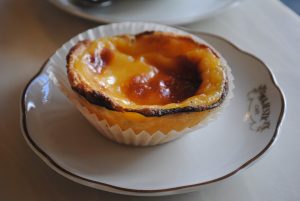by Clare Tierney, a second-year undergraduate in French and Portuguese at St John’s College
One of the most exciting parts of learning an ab initio language (learning a language from scratch) is the ab initio culture, I came to realise. Since starting Portuguese at Oxford in October 2016, I have delved into literature from the last 500 years, works of art, film, but, perhaps most important to me personally has been the food and drink. Much to my recently-gained chagrin, Portuguese cuisine is a bit of an unknown quantity in Britain. Nando’s could speak for Portugal, though few diners are actually aware of its Luso heritage, leaving Spain’s chorizos to single-handedly sum up food on the Iberian peninsula. But Portugal can most certainly hold its own when it comes to wining and dining.
The faculty wasted no time in acquainting us with Portuguese wine, putting on a tasting of both Portuguese and Brazilian, red and white during our pre-sessional course, which is an intensive introduction to the language. Here we discovered vinho verde. Relatively uncommon in England, this lightly sparkling white is delightful, and trips to Lisbon and Porto this past summer confirmed my positive opinion. None of the binge drinking nonsense in a restaurante tradicional: it’s 6€ a bottle when dining in, which is inviting excitable young Brits like us to drink with food, i.e. responsibly! Then we come to the Sagres beer, which is affiliated with the Lisbon team Benfica, and is both light and flavourful. What’s more, it is named after the coastal promontory on which Henry the Navigator had a chapel built in 1459. At the geographical extremity of their homeland, the discoverers would pray for safety on their voyages to map the world. Nothing could be more Portuguese than this, uniting sailing the seas, beer and football in a single product.

So what about food? The ingenuity of persecuted Jews during the Inquisition has stayed part of the country’s gastronomy in the form of alheira: a deep-fried medley of meats shaped, as sausages, to resemble their Christian oppressors’ pork equivalent. The pastel de nata or custard tart was also the invention of the religious community, though in this case it was the Catholic monks’ means of generating income. From their humble origin in 1837, they were named one of the ‘Seven Gastronomic Marvels of Portugal’ in 2011. The alheira sausage was too named, along with paella’s lesser known (but clearly award-winning) sibling arroz de marisco (the self-explanatory seafood rice). And this is still neglecting the expertly made coffee at 60 cents a cup in the centre of the capital city, not to mention the infinite list of of beans and fish with their equally infinite lists of accompanying seasonings and cooking methods ranging from garlic and on the grill, to frying in olive oil. A year abroad full of omega-3, caffeine and theological heritage awaits me and my stomach!
